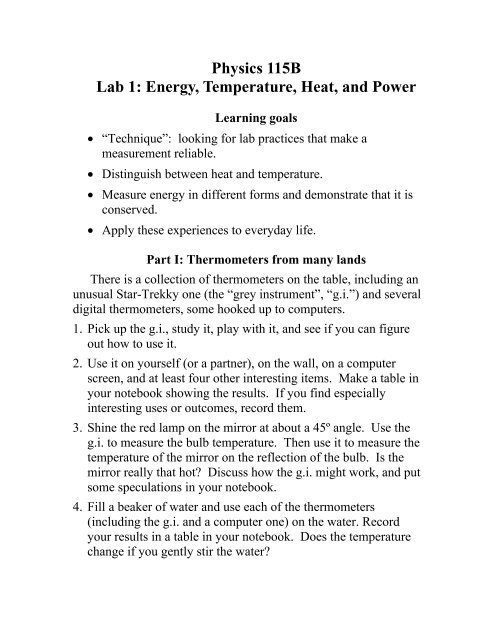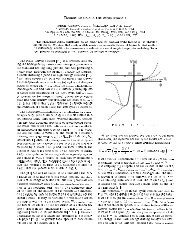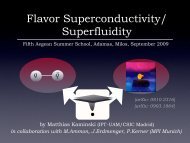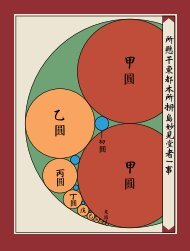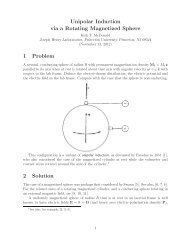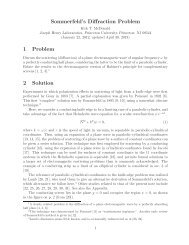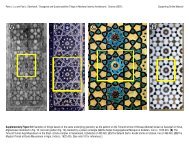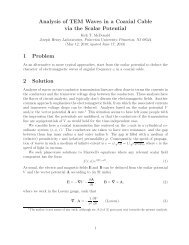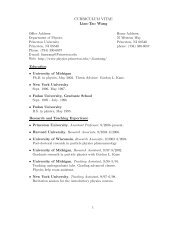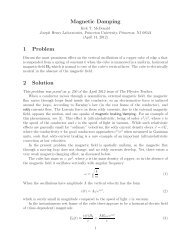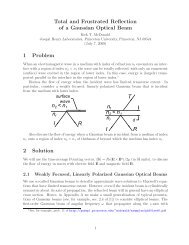Physics 115B Lab 1: Energy, Temperature, Heat, and Power
Physics 115B Lab 1: Energy, Temperature, Heat, and Power
Physics 115B Lab 1: Energy, Temperature, Heat, and Power
Create successful ePaper yourself
Turn your PDF publications into a flip-book with our unique Google optimized e-Paper software.
<strong>Physics</strong> <strong>115B</strong><br />
<strong>Lab</strong> 1: <strong>Energy</strong>, <strong>Temperature</strong>, <strong>Heat</strong>, <strong>and</strong> <strong>Power</strong><br />
Learning goals<br />
“Technique”: looking for lab practices that make a<br />
measurement reliable.<br />
Distinguish between heat <strong>and</strong> temperature.<br />
Measure energy in different forms <strong>and</strong> demonstrate that it is<br />
conserved.<br />
Apply these experiences to everyday life.<br />
Part I: Thermometers from many l<strong>and</strong>s<br />
There is a collection of thermometers on the table, including an<br />
unusual Star-Trekky one (the “grey instrument”, “g.i.”) <strong>and</strong> several<br />
digital thermometers, some hooked up to computers.<br />
1. Pick up the g.i., study it, play with it, <strong>and</strong> see if you can figure<br />
out how to use it.<br />
2. Use it on yourself (or a partner), on the wall, on a computer<br />
screen, <strong>and</strong> at least four other interesting items. Make a table in<br />
your notebook showing the results. If you find especially<br />
interesting uses or outcomes, record them.<br />
3. Shine the red lamp on the mirror at about a 45º angle. Use the<br />
g.i. to measure the bulb temperature. Then use it to measure the<br />
temperature of the mirror on the reflection of the bulb. Is the<br />
mirror really that hot? Discuss how the g.i. might work, <strong>and</strong> put<br />
some speculations in your notebook.<br />
4. Fill a beaker of water <strong>and</strong> use each of the thermometers<br />
(including the g.i. <strong>and</strong> a computer one) on the water. Record<br />
your results in a table in your notebook. Does the temperature<br />
change if you gently stir the water?
5. Put your h<strong>and</strong>s around the beaker <strong>and</strong> repeat Step 4 with the<br />
computer thermometer. Is the energy of the water changing?<br />
Why? Does the temperature change if you stir gently? Why?<br />
6. Describe in one paragraph some real-world situations where the<br />
g.i. would be useful. Describe cases in which it would be<br />
inaccurate.<br />
Part II: Liquid Nitrogen Demos<br />
The AI’s will show you cool things with serious cold!!
Part III: Transforming Kinetic <strong>Energy</strong> to <strong>Heat</strong> <strong>Energy</strong><br />
1. Carefully open the bottle <strong>and</strong> see what is inside. Measure the<br />
temperature inside using a digital thermometer. Make sure the<br />
thermometer doesn’t touch the bottom of the plastic bottle.<br />
Leave the thermometer in place to see how long the temperature<br />
takes to stabilize.<br />
2. Describe (to your lab partners <strong>and</strong> in your notebook) what<br />
would happen if you shook the bottle vigorously <strong>and</strong> then set it<br />
down. We want a description in terms of energy. (<strong>Energy</strong> in<br />
what form? From where?) Would the energy content of the<br />
bottle change? What about the temperature? What if you<br />
waited awhile afterward?<br />
3. Put the lid on the bottle <strong>and</strong> shake it 40 times vigorously.<br />
Repeat your temperature measurement. Watch it for a while.<br />
Record what you observe, then graph the result. Compare what<br />
you observe to your expectation in Step 2. Try repeating the<br />
experiment several times. (Everyone should do it at least once.)<br />
Why might such repetition be useful? Describe several reasons.<br />
4. There is a big brass object attached to the table. On top of it,<br />
there is a hole where you can insert a digital thermometer <strong>and</strong><br />
measure its temperature. Using friction with the belt, try to<br />
increase its temperature by 2°C. Do you have more respect for<br />
heat energy now? Note: please don’t let the belt slip off the<br />
object – this could damage the thermometer probe.
Part IV: <strong>Heat</strong> <strong>and</strong> <strong>Temperature</strong><br />
Using the materials available on the table, we’ll take a look at<br />
how objects store heat. In order to get this accurately, you’ll need<br />
to make some careful measurements <strong>and</strong> record the data in your<br />
notebook. You will follow the steps listed below. Read the steps<br />
now, but, before you do them, read the rest of this section. You<br />
should underst<strong>and</strong> exactly how the steps will allow you to<br />
determine the specific heat of your sample before you start making<br />
the measurements.<br />
1. Get a metal block from an AI <strong>and</strong> measure its mass (M metal ).<br />
Also measure the mass of an empty styrofoam cup.<br />
2. Fill a beaker with cold water <strong>and</strong> ice. You’ll find those in the<br />
fridge/freezer.<br />
3. Put tap water in a styrofoam cup <strong>and</strong> measure its total mass.<br />
From that determine the mass of the water (M H20 ). There should<br />
be just enough water in the cup just to have your block<br />
completely submerged. Measure its temperature without the<br />
block (T H20,intial ). You can use two probes on the same<br />
computer, one for the ice water, one for the tap water.<br />
4. Attach a string to the metal sample <strong>and</strong> put it in the ice water.<br />
Measure the temperature of the water (T ice water =T metal,initial ).<br />
5. Then, carefully place the metal sample in the styrofoam cup of<br />
water. Stir <strong>and</strong> track the temperature on the computer. When it<br />
reaches a constant value, record it: (T H20,final =T metal,final ).<br />
We can connect the temperature change of the water to energy.<br />
Recall from your textbook that the heat (energy) required to raise<br />
the temperature of 1 kg of water by 1°C is 1 Calorie ≈ 4200 J, so it<br />
takes about 4.2 J to raise 1 g of water by 1°C. How much did the<br />
temperature of the water in the styrofoam cup change when the<br />
block was added? How many Joules of heat energy did the water<br />
lose? What principle allows you to determine the change in the
energy of the block? By how much did its energy change? Did its<br />
temperature change by the same amount as the water?<br />
<strong>Temperature</strong> <strong>and</strong> heat are related, but not the same! Each<br />
substance has a “specific heat,” the amount of energy needed to<br />
raise 1 g of the substance by 1°C. From the above discussion, the<br />
specific heat of water is C H2O ≈ 4.2 J/g-°C. (It can also be quoted<br />
in other units, for example, 1 Cal/kg-°C.) C does not depend on<br />
the mass, shape, or temperature of the material – it just depends on<br />
what the object is made of.<br />
Use this definition <strong>and</strong> your measurements to figure out the<br />
specific heat, Cmetal, for your block. Report your result to one of<br />
the AI’s – we will compare the values measured by the different<br />
groups in all the labs. Does your metal or water have the higher<br />
specific heat?<br />
Discuss <strong>and</strong> list some real-world situations when having a<br />
material with high specific heat or low specific heat can be<br />
important.
Part V: Electrical <strong>Energy</strong> <strong>and</strong> <strong>Power</strong> – a Watt is a Watt<br />
The 100-Watt light bulb has been set up for safe immersion in<br />
water. (Don’t try this at home!)<br />
1. First try plugging it into the Kill-A-Watt meter. Try the various<br />
buttons. How much electrical power is being used? We will try<br />
to measure this ourselves.<br />
2. Put enough tap water in the plastic water jug to cover the bulb.<br />
500 ml should do it. Figure out the mass of the water. (Why is<br />
it easy if you used 500 ml?) Put the probe of a digital<br />
thermometer in the water. It should not touch the wall of the<br />
jug or the bulb. Use a plastic ruler to stir the water gently.<br />
Measure the temperature of the water with the bulb off.<br />
3. Turn on the bulb. Record the temperature at fixed time<br />
intervals, say every 30 seconds, for several minutes. Stir the<br />
water gently <strong>and</strong> continuously with the ruler. Plot the<br />
temperature vs. time.<br />
4. We can connect the temperature change of the water to energy.<br />
Recall from your textbook that the heat (energy) required to<br />
raise the temperature of 1 kg of water by 1°C is 1 Calorie ≈<br />
4200 J, so it takes about 4.2 J to raise 1 g of water by 1°C. At<br />
what rate is energy being added to the water (J/s = Watts) while<br />
the bulb is on?
<strong>Physics</strong> <strong>115B</strong><br />
<strong>Lab</strong> 2: Atoms, molecules, <strong>and</strong> measuring the<br />
very small<br />
In this lab we will make a series of measurements using simple<br />
equipment (rulers, beakers, lab balances) that will give us<br />
estimates of molecular-scale quantities such as the size of a<br />
molecule, the wavelength of light, <strong>and</strong> Avogadro’s number.<br />
Learning goals<br />
Underst<strong>and</strong> the relative <strong>and</strong> absolute sizes of atoms,<br />
molecules, the wavelength of light, the average molecular<br />
spacing in a gas.<br />
Apply mathematical <strong>and</strong> geometrical concepts to the physical<br />
world.<br />
Underst<strong>and</strong> some techniques for making realistic<br />
measurements of things that are invisibly small.<br />
Warm-up 1: Guesses<br />
Do this exercise individually, without consulting lab partners or<br />
other sources. You won’t be judged (or graded) on the accuracy of<br />
your results – we really mean guess. This is for later comparison<br />
with what you’ll measure in today’s lab.<br />
1. In your notebook, rank in order of increasing size the<br />
following items:<br />
The wavelength of visible light<br />
The diameter of an atom<br />
The length of a molecule. We’ll be using an oil (oleic acid)<br />
with chemical formula C 18 H 34 O 2 , that forms a long chain of<br />
atoms, so use that in your thinking. Here’s a model:<br />
1
(Wikipedia, Oleic Acid)<br />
The average distance between molecules in air<br />
2. Guess numbers for the sizes, indicating both a guess for the<br />
size of each item <strong>and</strong> the ratios between adjacent sizes in your list.<br />
(Example: you might guess that an atom is 25 times larger than the<br />
wavelength of light.)<br />
Warm-up 2: Slick<br />
You know that oil floats on water, <strong>and</strong>, at least since the Gulf<br />
oil spill, you know that oil on water forms a “slick” – a very thin<br />
layer or film. Under controlled circumstances, this film can be one<br />
molecule thick! (So an oil spill spreads very far indeed.) It isn’t<br />
easy to prove that the layer is one molecule thick, but, by assuming<br />
this, we can measure the size (it turns out to be roughly the length)<br />
of an oil molecule, something Lord Rayleigh did in 1890. Though<br />
there are some practical issues, the concept couldn’t be simpler.<br />
Figure out how to determine the thickness t of the film<br />
formed by a volume of oil V by measuring the area of the<br />
film A.<br />
We make the patch of oil visible by dusting a bit of the surface<br />
of the water with baby powder. The AIs will demonstrate this.<br />
They will also suggest some assumptions we are making <strong>and</strong><br />
maybe test them.<br />
Parts I, II, <strong>and</strong> III can be done in any order – the AIs will get<br />
your group started on one after the demo, then move on to the<br />
others. Don’t forget Part IV at the end.<br />
Both Parts I <strong>and</strong> II will need you to measure the volume of a<br />
drop from an eyedropper. We will assume that all the droppers are<br />
the same (we tried a few, <strong>and</strong> they are at least similar), so your<br />
2
group need only measure one dropper for each part. We will not<br />
assume that a drop of oil-water mix (Part I) <strong>and</strong> a drop of<br />
turpentine (Part II) are the same size. 1 Do this as part of Part I <strong>and</strong><br />
II, as the graduated cylinders are available. For now, think how<br />
you would do it.<br />
Using oil-water or turpentine <strong>and</strong> one of the 25-ml graduated<br />
cylinders, determine the volume of one drop from your<br />
eyedropper. Each group member should try this, using the<br />
same dropper. Record all the measurements for your group.<br />
Part I: Measuring the size of a molecule with a ruler<br />
The trick now is to make this quantitative, <strong>and</strong> what makes it<br />
hard is that V must be known <strong>and</strong> must be quite small to keep the<br />
film smaller than our pans. (Rayleigh used a very large pan; Ben<br />
Franklin, who started all this, publishing an account in 1774, used<br />
a pond.) As part of the Warm-up 2 demo, the AIs will make a<br />
1:1000 mixture of oil:water. Oil <strong>and</strong> water, famously, do not mix,<br />
but we can do well enough by making a suspension of tiny oil<br />
droplets. When you put a drop of the mix in your pan of water, the<br />
water in the mix will just enter the water in the pan, leaving the oil<br />
droplets to join <strong>and</strong> form the film.<br />
Measure the volume of a drop of the oil-water mix, as<br />
described in Warm-up 2.<br />
Make several measurements of areas of films, each from a<br />
single drop, in the pans, recording the results. (You may<br />
only get to do one trial per pan. Let the AIs know if you<br />
need to reuse a pan – they can help dump it out <strong>and</strong> clean it<br />
for another trial.)<br />
Estimate the size of a molecule of the oil, assuming that the<br />
film is one molecule thick. Remember that your drop was<br />
not all oil!<br />
1 We used to assume this, but then we tried it – it isn’t true!<br />
3
Assuming that all the measurements you have made are<br />
accurate, discuss what effects could make your estimate of<br />
the molecular size too big? too small?<br />
From the size of a molecule, estimate the number of oil<br />
molecules in a cubic centimeter of oil. This is called the<br />
number density, n. To do this, you need to make<br />
assumptions about the shape of an oil molecule. Assume<br />
that the molecules are cubes that are packed together. (This<br />
turns out to be a poor assumption – see the picture on page 1<br />
– but it will do for now.) You can (<strong>and</strong> should) calculate the<br />
number of oil molecules in your film. It is surprising that<br />
you can measure such a number (even roughly) so simply!<br />
For the next steps, we will need the density (mass per cubic<br />
centimeter) of the oil. The AI’s have some oil you can use<br />
to measure this. Give the oil back to them when you are<br />
done.<br />
The oil we are using is oleic acid, the major component of olive<br />
oil. (Rayleigh <strong>and</strong> Franklin just used olive oil.) Oleic acid is<br />
described by the chemical formulas<br />
C 18 H 34 O 2 or CH 3 (CH 2 ) 7 CH = CH (CH 2 ) 7 COOH .<br />
The important constant Avogadro’s number, N A , is the number of<br />
atoms or molecules of a substance in a mole of that substance. The<br />
atomic or molecular weight is the mass in grams of a mole of<br />
atoms or molecules of a given type. The atomic weights of<br />
hydrogen, carbon, <strong>and</strong> oxygen are 1, 12, <strong>and</strong> 16, respectively, so,<br />
for example, a mole of carbon atoms has a mass of 12 g.<br />
From this information, what is the molecular weight of oleic<br />
acid?<br />
Using this molecular weight <strong>and</strong> your measurements,<br />
calculate an estimate of N A , Avogadro’s number.<br />
4
Discuss factors that could cause your estimate to vary from<br />
the accepted value, N A = 6.02×10 23 molecules/mole. <br />
Note from the right-h<strong>and</strong> chemical formula above <strong>and</strong> the<br />
picture on page 1 that oleic acid is a chain of carbon <strong>and</strong> oxygen<br />
about 20 atoms long. (The structure is a bit bent, but we’ll ignore<br />
that.)<br />
From your measurements, what is the diameter of an atom?<br />
Part II: The wavelength of light<br />
As we will study later in the course, light is an electromagnetic<br />
wave. No matter is moving in this wave – what is oscillating as the<br />
wave propagates is the strength of electric <strong>and</strong> magnetic fields.<br />
Though this is very abstract, our usual picture of a wave applies,<br />
but with a different meaning of the graph.<br />
whole pattern<br />
moves<br />
wavelength<br />
<br />
We often ask questions like this, <strong>and</strong> it is worth noting what we are looking for.<br />
We are not looking for “I could have forgotten a term in my equation.” or “I could have<br />
multiplied wrong.” or “I could have weighed the sample wrong.” Even though we call<br />
this exercise “underst<strong>and</strong>ing the errors,” that does not mean mistakes. We are looking for<br />
specific effects or inaccurate assumptions (explicit or hidden) that could have distorted a<br />
measurement or its interpretation. An example from this lab would be assumptions about<br />
the shape of an oil molecule. An example from last week would be the assumption that<br />
no heat was lost through the wall of a beaker. You should not only list such effects, but<br />
indicate, if possible, the direction they would change your result. For example: “Not<br />
taking into account the heat entering through the wall of the beaker during the<br />
measurement would make our measured specific heat too small.”<br />
5
Instead of the graph representing, say, the height of the water<br />
surface in an ocean wave, it can be the strength of the electric field.<br />
A stationary observer would measure the electric field getting<br />
stronger <strong>and</strong> weaker as the wave went by, just as a person in the<br />
ocean would bob up <strong>and</strong> down as a water wave passed.<br />
Like any sine wave, this wave has a wavelength, the distance<br />
between two adjacent crests or troughs, for which we use the<br />
Greek letter lambda, . We can ask, If light is a wave, what is its<br />
wavelength? You may know that the wavelength of light depends<br />
on its color. Since we just want an order-of-magnitude estimate,<br />
this won’t matter to us (though it will make the patterns we<br />
observe quite beautiful.)<br />
Dip a wire-loop in the bubble solution. Go ahead – blow a<br />
bubble or two! Look specifically at the reflections of the<br />
room lights, noting that the reflections are pretty colors, not<br />
the white of the lights themselves. We can make the pattern<br />
of colors more regular. Dip the loop again. This time hold it<br />
so the loop is vertical <strong>and</strong> look at the reflections in the flat<br />
bubble spanning the loop. Note that there are horizontal<br />
b<strong>and</strong>s of alternating green <strong>and</strong> red. The pattern moves as the<br />
water drains downward, making the film thinner.<br />
Eventually, there is no reflection at all from the top, even<br />
though the bubble hasn’t popped yet (though it is about to.)<br />
Each member of the group should make <strong>and</strong> observe this<br />
pattern.<br />
As we’ll learn when we study waves later in the course, the<br />
b<strong>and</strong>s of color appear when the film is about a wavelength thick,<br />
via a process called interference. In fact, for a color with<br />
wavelength , when the film is ¼×, ¾×, 5/4× thick you see a<br />
bright reflection of that color. Because gravity drains the water<br />
downward, the bubble in the loop is thinner at the top <strong>and</strong> thicker<br />
at the bottom, <strong>and</strong> there are horizontal b<strong>and</strong>s of constant thickness.<br />
This means the green <strong>and</strong> red reflections alternate as each color<br />
6
goes through the multiples of its . As the water drains, the pattern<br />
shifts downward. Eventually, the top of the bubble is less than ¼-<br />
wavelength thick <strong>and</strong> there is no color that reflects, that is, no<br />
reflection at all. For our purposes, we just need the fact that when<br />
there are a few b<strong>and</strong>s present, the film is about a wavelength thick.<br />
To make this quantitative, we will use a variant of the same<br />
trick used in Part I. In this part, we use turpentine. We use<br />
turpentine because, for some reason, it forms films that show<br />
interference b<strong>and</strong>s. This tells us the film is about a wavelength<br />
thick, even if we don’t know why that happens. Note that, unlike<br />
the oil we use in Part I, the turpentine evaporates quite rapidly.<br />
This means that there is some uncertainty about the volume of<br />
turpentine remaining. On the plus side, it means we can try several<br />
drops in succession in the same pan without dumping it <strong>and</strong><br />
restarting.<br />
To make our measurements of the wavelength of light, we will<br />
drop one drop of turpentine into a tray of water. To know the film<br />
thickness is about a wavelength, we need to see the colored<br />
reflection b<strong>and</strong>s. We have found that in the black pans we are<br />
using, it is easy to see both the b<strong>and</strong>s <strong>and</strong> the edge of the slick<br />
without using any baby powder.<br />
Measure the volume of a drop of turpentine, as described in<br />
Warm-up 2.<br />
Make observations of what happens when you put a drop of<br />
turpentine on the water. Make sketches of what you see or<br />
describe it in words. We have always seen one oddity: the<br />
first drop spreads to cover the whole tray, but subsequent<br />
drops make near-circular films of reasonable size. Measure<br />
the diameters of all films after the first. Note roughly how<br />
long after the drop you see the colors appear, when they<br />
vanish, <strong>and</strong> when the film itself vanishes. We found that you<br />
can do five or six drops in the pan before it gets too messy.<br />
7
Estimate the wavelength of light using your observations <strong>and</strong><br />
measurements.<br />
Part III: Weighing air<br />
It seems odd, but it turns out to be easy to weigh air. Your<br />
equipment: a flask with a valve, a balance, <strong>and</strong> a vacuum pump.<br />
The pump can suck just about all the air out of the flask in about a<br />
minute. (The flasks have a protective coating <strong>and</strong> are glued inside<br />
the boxes for safety.) Note the valve with the black h<strong>and</strong>le on the<br />
flask. It is open when the h<strong>and</strong>le points straight out from the stem.<br />
Figure out how to find the mass of air in the flask <strong>and</strong> do it –<br />
record the result. Pretty easy. Do it again (have each group<br />
member try it) to see if you get the same result. What would<br />
happen if you tried to weigh helium this way?<br />
Use your result to find the density (g/cm 3 ) of air. What do<br />
you need to do this? Figure this out with the tools at h<strong>and</strong>.<br />
Air is mostly nitrogen molecules, N 2 . (For simplicity, we’ll<br />
assume it is all nitrogen. The oxygen molecules have about the<br />
same mass, so this is a fine approximation.) The molecular weight<br />
of nitrogen is 28, so one mole of N 2 has a mass of 28 g. In Part I,<br />
you determine the number of molecules in a mole, called<br />
Avogadro’s number, from measurements you made. Don’t worry<br />
if you haven’t done Part I yet – here we’ll use the actual value, N A<br />
= 6.02×10 23 molecules/mole.<br />
From your measured density of air, the molecular weight of<br />
N 2 , <strong>and</strong> the value of N A , find the number density, that is, the<br />
number of molecules per cm 3 of air.<br />
Now figure out the average distance between air molecules.<br />
This will take some thinking <strong>and</strong> discussion in your group.<br />
Indicate your reasoning in your notebook.<br />
8
Part IV: Summary<br />
Remake the same list from Warm-up 1, using the results of this<br />
lab, including the sizes <strong>and</strong> ratios from your measurements.<br />
9
<strong>Physics</strong> <strong>115B</strong><br />
<strong>Lab</strong> 3: Motion<br />
Learning goals<br />
Perform an experiment that demonstrates the predictive<br />
power of Newton’s laws.<br />
Apply the laws of motion in two dimensions.<br />
Determine <strong>and</strong> observe the constraints placed on spinning<br />
objects by conservation laws (energy <strong>and</strong> angular<br />
momentum.)<br />
Warm-up 1<br />
As director of research for a toy manufacturer, you regularly<br />
receive proposals for new toys. Indicate which of these seem<br />
possible for an inexpensive toy with no internal power source<br />
(battery, etc.):<br />
a) A plastic top that spins on a plastic base for weeks.<br />
b) A simple top that, while spinning, flips over so that its larger,<br />
heavier end is on top.<br />
c) A specially weighted wheel that rolls back <strong>and</strong> forth on a V-<br />
shaped ramp for weeks.<br />
d) A specially weighted wheel that rolls back <strong>and</strong> forth on a V-<br />
shaped ramp, reaching a higher point on the ramp on each<br />
pass.<br />
e) The situation in c) <strong>and</strong> d) if you know there are magnets in<br />
the wheel <strong>and</strong> the base.<br />
1
Part I: Catch the ball<br />
On the table is a track on which a cart can roll with very little<br />
friction. The top section of the cart is a launcher that shoots a ball<br />
straight up. Ask an AI to show you how to activate the launcher.<br />
Never st<strong>and</strong> with your face directly above the launcher – it can<br />
fire without warning!!! There is also an adjustable spring that<br />
can give the cart a reproducible velocity along the track.<br />
First: read through all of Part I so you’ll underst<strong>and</strong> the overall<br />
goal of these steps.<br />
Determine how high the ball goes when launched with the<br />
cart at rest. This takes at least two people: one to trigger the<br />
launcher <strong>and</strong> hold the meter stick, <strong>and</strong> one or more to watch<br />
how high the ball goes. Do quite a few trials with each<br />
member of your group launching <strong>and</strong> watching the height.<br />
Everyone should have a record of all the launches. Look for<br />
reproducibility in two forms: precision, how close in height<br />
are the launches? are there outliers, occasional misfires that<br />
go to a quite different height? Also, be sure to decide what<br />
you should define as the initial height of the ball.<br />
At this point, ask the AI to take the ball away. Ask your AI to<br />
demonstrate the cart-launching spring <strong>and</strong> how to adjust it.<br />
You will use a light gate (an LED light source <strong>and</strong> light<br />
sensor that straddle the track <strong>and</strong> a timer) to measure the<br />
cart’s speed just before it launches the ball. You shouldn’t<br />
have to do anything to the timer other than turning it on<br />
(power switch on the back) <strong>and</strong> hitting the reset button on<br />
the front. Figure out how this system works. (Try passing<br />
your h<strong>and</strong> between the LED <strong>and</strong> the sensor. What happens?)<br />
How can you use this setup to measure the speed of the cart?<br />
Note the setting of the cart-launching spring (see the scale on<br />
the side of the launcher) <strong>and</strong> record it in your notebook.<br />
2
Without launching the ball, launch the cart several times,<br />
again looking for reproducibility in both forms.<br />
Knowing the velocity of the cart <strong>and</strong> the height the ball<br />
reaches, compute the location where the ball will l<strong>and</strong> (see<br />
formula below). Place the cup at that location, making sure<br />
the bumper is between the ball-launch point <strong>and</strong> the cup.<br />
Call the AI over. He’ll give the ball back <strong>and</strong> observe.<br />
Launch the cart with the ball-launcher armed. If the ball is<br />
caught in the cup, congratulations! Try it again. If not,<br />
check the calculations <strong>and</strong> the velocity <strong>and</strong> try again.<br />
Now remove the cup, move the bumper to the far end of the<br />
track. Discuss where the ball (launched straight up from the<br />
cart) will l<strong>and</strong> – ahead of the cart? behind the cart? in the<br />
cart? What if the cart is launched faster? Slower? Write<br />
your predictions in your notebook. Now try a few more<br />
launches. Vary the cart speed by just giving it a push with<br />
your h<strong>and</strong> <strong>and</strong> recording the velocity without adjusting the<br />
launcher. What do you observe? (No numbers needed, just<br />
watch.) Why does it make sense?<br />
Useful formula:<br />
The time it takes an object to fall a height h starting at rest is<br />
2h<br />
t fall<br />
,<br />
g<br />
where g is the gravitational acceleration, g = 9.8 m/s 2 = 980 cm/s 2 .<br />
(See pp. 11-12 of Chapter 3 in your textbook. If you know how to<br />
derive this result, show your lab partners, but for this lab we will<br />
take it as given.) Figure out how to use this formula in your<br />
calculation of where to put the cup. Show your reasoning <strong>and</strong> all<br />
calculations in your notebook.<br />
The Big Picture: this is the essence of Newtonian determinism,<br />
discussed in lecture. Given the initial position <strong>and</strong> velocity of an<br />
3
object <strong>and</strong> knowledge of the forces, the object’s future position is<br />
completely predictable. Where in your calculation did you express<br />
the knowledge of the forces? The underst<strong>and</strong>ing of situations like<br />
those in your last measurements (without cup or bumper) were<br />
essential to Galileo’s realization that the Earth could, in fact, be<br />
moving.<br />
Part II: Spinning toys<br />
This lab will be our only look at things that spin. We’ll mostly<br />
just ask that you observe, but we do want you to realize that<br />
conservation of energy <strong>and</strong>, as we will see in Part III, a new<br />
quantity called angular momentum, are universal.<br />
The toys in this section fall into three categories.<br />
Category 1: spin the “Top secret top,” the little silver top on<br />
the round black st<strong>and</strong>. Start the “Space wheel,” the little<br />
satellite thingy, by putting it on its rails (the two vertical<br />
transparent plates on a black st<strong>and</strong>) near one end <strong>and</strong> letting<br />
go from rest. Just start each one once <strong>and</strong> let them do their<br />
thing while you go on to the other toys.<br />
Category 2: Before the first spins, guess how long each toy<br />
will spin. Take turns spinning the “Quark top” <strong>and</strong> the<br />
“Euler disk” on their mirrors. (The mirrors are just smooth<br />
surfaces.) Time how long each spins. To set the Euler disk<br />
going, you place on edge at a slight angle (tilted on the edge<br />
that that is rounder; the sharper edge tends to scratch the<br />
surface) on its mirror (the slightly concave one). If you give<br />
it a good spin it will spin like a coin. Record in your<br />
notebook interesting things you observe with the Euler disk<br />
as it comes to rest.<br />
Category 3: There are three similar tops, two green wooden<br />
ones <strong>and</strong> one orange/green plastic one, that do something<br />
odd. (Have an AI show you how to work the button on the<br />
4
plastic top.) Why is this flipping behavior unexpected?<br />
What must be true about the motion for this to be consistent<br />
with conservation of energy? Though the sippy birds are not<br />
spinning, their iconic behavior is odd. What might provide<br />
the energy needed for them to keep going despite friction?<br />
Now look back at the Category 1 toys. Can they actually be<br />
frictionless? (Hint: no.) What if we told you (truthfully)<br />
that they’d keep going for days or weeks? What would you<br />
suspect was going on? (Hint: aren’t the bases a bit heavy?)<br />
Try starting the satellite thingy at a point about halfway to<br />
one end.<br />
Compare your underst<strong>and</strong>ing with your responses to the<br />
Warm-up.<br />
Part III: Angular momentum (<strong>and</strong> more toys)<br />
If you are uncomfortable trying this, do it very slowly<br />
<strong>and</strong>/or ask an AI to help you. You must be careful – if<br />
you spin too fast you can hurt yourself by falling off or<br />
someone else by hitting them, especially when you get<br />
dizzy! Sit on the comfy chair. Sit upright (don’t lean in any<br />
direction), with you arms extended horizontally to the sides.<br />
Push yourself with your feet, or have a lab partner push your<br />
arm so you turn slowly. When you are turning steadily,<br />
bring you h<strong>and</strong>s in to your chest. What happens to your rate<br />
of spin? Put your arms back out. What happens? Everyone<br />
should try this – if you are nervous, do it in the reverse order,<br />
starting with your arms in. This will be quite tame. You can<br />
try this with the dumbbells in your h<strong>and</strong>s. If you do, start<br />
with arms in.<br />
Sit on the stool again. Have a partner spin up the bicycle<br />
wheel as fast as possible (note that this one is meant to turn<br />
only in one direction). Have him/her h<strong>and</strong> the wheel to you<br />
5
with the axle oriented vertically. With the stool at rest <strong>and</strong><br />
with you holding the axle firmly at both ends, turn the wheel<br />
over, so that the axle that was on the bottom is now on the<br />
top. What happens?<br />
St<strong>and</strong> on the floor (no chair this time) <strong>and</strong> spin the wheel<br />
with the axle horizontal. Try to turn the wheel as if you<br />
were steering it for a left turn, keeping it upright. Hold the<br />
axles tightly, but let your arms respond to what the wheel<br />
does.<br />
Find an AI <strong>and</strong> describe your observations to him. We will try<br />
to extract the properties of a new quantity called angular<br />
momentum from your observations.<br />
Find the colored plastic oblongs. Try spinning them on a<br />
table, first counter-clockwise then clockwise. Why is this<br />
behavior odd? Does it violate the law of conservation of<br />
angular momentum? Why or why not?<br />
Just for fun: turn over the pair of connected bottles to see the<br />
tornado. Spin the water-filled gyroscope.<br />
Find the book held closed by the rubber b<strong>and</strong>. Try flipping it<br />
in the air about each of its three perpendicular axes. What<br />
do you observe? This odd behavior is universal <strong>and</strong> well<br />
understood from Newton’s Laws.<br />
Part IV: Air<br />
An AI will do a demonstration in which the big vacuum cleaner<br />
can support a ball on its air jet. What must the direction of the net<br />
force of the air on the ball be?<br />
6
<strong>Physics</strong> <strong>115B</strong><br />
<strong>Lab</strong> 4: Radioactivity<br />
In this lab, we will study radioactivity. Chapter 4 of your<br />
textbook is a good introduction to the physics <strong>and</strong> the terminology,<br />
but also to the effects of radiation. You probably know a bit, <strong>and</strong><br />
you will learn more in this course, about the technological,<br />
political, <strong>and</strong> health impacts of radioactivity. From a scientific <strong>and</strong><br />
philosophical point of view, however, radioactivity <strong>and</strong> radiation<br />
are a direct, observable connection to the atomic <strong>and</strong> sub-atomic<br />
world.<br />
Though some of the sources of radioactivity we will use are<br />
created for scientific purposes, several are from the grocery store<br />
or the hardware store <strong>and</strong> are found in almost every home. We<br />
will get the radioactive atoms for one part of the lab from the air.<br />
None of the sources used in this lab are dangerous. Still, we<br />
will apply sensible rules that should always be applied to<br />
radioactive sources.<br />
1. Minimize contact. Hold the needle sources by the stopper<br />
only. Keep them in their tubes when not in use. Hold the<br />
plastic disk sources by the edge. Don’t touch the actual<br />
source in the smoke detector. Decide what you are going<br />
to do with a source before you pick it up, <strong>and</strong> then do it.<br />
2. Keep track. If your group is using one or more sources,<br />
each member should know where each source is. Never<br />
put the source in your pocket or somewhere hidden where<br />
it can’t be seen. Return the source to an AI when done.<br />
3. No eating (or food) or drinking in the lab. Wash your<br />
h<strong>and</strong>s before leaving the lab.<br />
4. When in doubt, ask an AI.<br />
To start this lab, look at the Learning Goals <strong>and</strong> the questions in<br />
Part III; use them to guide your investigations in Parts I <strong>and</strong> II.<br />
1
Learning goals<br />
Perform measurements of things you cannot see.<br />
Distinguish different types of radiation <strong>and</strong> different types of<br />
radioactive materials by measuring their penetration power,<br />
half-life, <strong>and</strong> tracks in the cloud chamber.<br />
State evidence that radiation is made of particles.<br />
Explain how half-life is a property of exponential decay.<br />
Measure radiation from everyday objects.<br />
Part I: Geiger-Mueller counter<br />
The Geiger-Mueller counter is a very sensitive device that can<br />
detect the passage of individual particles (beta <strong>and</strong> gamma <strong>and</strong><br />
maybe alpha rays) from radioactive decays. Because it can detect<br />
individual decays, it allows you to count them, hence “counter.”<br />
Your AI can describe how it works. Our G-M counters (GM-45s)<br />
are connected to computers, so the results can be stored <strong>and</strong><br />
plotted. The computers are trained to make the traditional “clicks”<br />
that let you get a sense of how many decays are detected without<br />
plotting. We will find it most useful to measure the rate of<br />
detected decays. The computer does this by counting for a minute,<br />
plotting the result, then doing the same thing for the next minute,<br />
etc. The displayed rate is the counts per minute, or CPM.<br />
The instructors will demonstrate how to use the GM-45<br />
counters. They will also introduce some of the concepts we<br />
need to study radioactivity.<br />
Note that the counting is a statistical process. Governed<br />
directly by quantum mechanics – it is fundamentally r<strong>and</strong>om.<br />
Even with measurements of perfect precision, we do not expect to<br />
get the same number of counts in each minute! This means that we<br />
must do some averaging, either numerically or by eye. It also<br />
means that we must be patient <strong>and</strong> let the average unfold. During<br />
the longer measurements, you can work on Part II.<br />
2
First make sure the computer is operating <strong>and</strong> recording<br />
data. The first thing to measure is the room background, the<br />
rate of counts with no source present. This may be partly an<br />
occasional misfire of the GM-45, but it is mostly<br />
radioactivity in the materials used to make the device itself<br />
<strong>and</strong> in the air <strong>and</strong> other surroundings (including you).<br />
Record this number – you will want to subtract it from all<br />
measurements of other sources.<br />
The AIs will give each group a source. Write down what<br />
your source is. Place it gently on the GM-45 (the mesh is<br />
fragile). Record the rate. Try some other sources.<br />
Use the ringst<strong>and</strong> <strong>and</strong> clamp to hold the Co-60 or Cs-137<br />
source at various heights above the GM-45, say 4, 8, 16,…<br />
cm. Before you take the measurements, what do you expect<br />
to see? (We are looking for something more specific that “It<br />
will decrease.”) Plot the count rate vs. distance. Discuss the<br />
result.<br />
We can learn a bit about the radiation from the source by<br />
trying to block it. There are various sheets of materials from<br />
paper to metal in various thicknesses. Carefully remove the<br />
plastic cover from the smoke detector <strong>and</strong> the metal cover<br />
from the source itself, then put it face-down on the GM-45,<br />
as the AI did in the demo. Try the various materials between<br />
your source <strong>and</strong> the GM-45. Start with one, then 2, then<br />
more sheets of paper, then go to the heavier materials. What<br />
do you conclude about the source?<br />
Try this shielding test with another source if there is time.<br />
In a radioactive material, individual nuclei decay to other<br />
nuclei, emitting particles that we call radiation (the old name was<br />
rays). We now know what these rays are: alpha rays are helium<br />
nuclei (these are made of two protons <strong>and</strong> two neutrons, an<br />
especially stable configuration that can be emitted as a unit from a<br />
larger, less stable nucleus); beta rays are electrons, <strong>and</strong> gamma<br />
3
ays are photons, the quantum-mechanical particles of light, but<br />
with energies much higher than visible light. X-rays are just lessenergetic<br />
gamma rays.<br />
Note how the particle model is “obvious” here: we count them.<br />
(We’ll address this again in a later lab.) The particles have specific<br />
properties, notably mass <strong>and</strong> electric charge. The most intuitive<br />
property, the particles’ sizes, turns out to be unimportant here.<br />
They are all so small compared to the size of atoms that none of<br />
our measurements reveal any information about particle size.<br />
If the radioactive nuclei are decaying, should they eventually be<br />
gone entirely? Yes! For the sources we’ve been using so far, this<br />
takes years (Co-60), or tens of years (Cs-137, Sr-90), or hundreds<br />
of years (Am-241), or even billions of years (K-40), so you haven’t<br />
seen it in your measurements.<br />
When radioactive nuclei decay, they do so in an odd way. Each<br />
type of unstable nucleus has its own half-life: the time it takes for<br />
half of the individual nuclei of that type in a sample to decay.<br />
Example: the half-life of Americum-241 is 432 years. The odd<br />
thing is that after 432 years, when half the original Americium is<br />
gone, it is not the case that the other half is about to kick. In fact,<br />
half of the remainder will live another 432 years, exactly as if the<br />
whole surviving half had just been born. Your text calls this<br />
“dying, but not aging.” Mathematically, this is exponential decay,<br />
which, along with exponential growth is observed in many natural<br />
phenomena (see Chapter 5 in your text).<br />
The problem with doing experiments with radioactive nuclei<br />
with a half-life short enough to measure in a 3-hour lab is that if<br />
you buy some on Monday, it’s mostly gone by Tuesday. Instead,<br />
we need something that is made continuously that we can harvest<br />
<strong>and</strong> observe. Fortunately (in a sense, see below for the downside),<br />
uranium <strong>and</strong> thorium in the Earth’s crust is slowly decaying, <strong>and</strong><br />
one of the resulting nuclei, Radon-222 (Rn-222), is a chemically<br />
inert but radioactive gas. It has a long enough half-life (about 4<br />
4
days) that it can seep out of the ground. When it seeps into a<br />
basement, it can collect there, <strong>and</strong>, if levels are high, can become a<br />
health problem. The nuclei that Rn-222 decays to (see Figure 1)<br />
are metals. They stick to dust particles in the air, <strong>and</strong> we can<br />
collect <strong>and</strong> concentrate them onto a paper filter by using the yellow<br />
air samplers that have been running in the adjacent classroom.<br />
Note from the figure that lead-210 ( 210 Pb) has a long half-life. It is<br />
thus a bottleneck, <strong>and</strong> what we will see is the decays that precede<br />
this. We will be most sensitive to the beta-decays of lead-214 <strong>and</strong><br />
bismuth-214. Because we are seeing a chain of linked decays, we<br />
will not observe a single half-life. For example, for awhile, as long<br />
as there is 218 Po (polonium-218), it will replenish the lead-214, <strong>and</strong><br />
likewise, the decay of the lead-214 replenishes the bismuth-214.<br />
Still, the nuclei will decay in tens of minutes, <strong>and</strong> we can find<br />
when the number of decaying nuclei has dropped to about half of<br />
its initial value.<br />
Note that we will be measuring the rate of decays (counts per<br />
minute), while our discussion of half-life above was in terms<br />
of surviving radioactive particles. Based on your<br />
underst<strong>and</strong>ing of half-life, predict the shape of the measured<br />
CPM vs. time you will see if you observe a sample with a<br />
single type of radioactive nucleus for several half-lives.<br />
Make a sketch, labeling the location of one half-life.<br />
5
Figure 1. The radioactive decay sequence of uranium-238. The portions<br />
relevant to this lab are highlighted. The half-life of each nucleus is in its box<br />
(note the different units!), with the type of decay (, ) between it <strong>and</strong> the next<br />
box. (Note: a + is a positive electron: a bit of anti-matter!)<br />
6
When you’ve read the above description, make another room<br />
background measurement by leaving your GM-45 with no<br />
source on it for a few minutes. Then place an unused paper<br />
filter on the GM-45 to see if it changes the count rate.<br />
Go with an AI to get a sample from the air samplers.<br />
Choose one <strong>and</strong> shut it off, noting the time <strong>and</strong> the time on<br />
the blackboard indicating when the sampling started.<br />
Carefully remove the paper ring holding the filter paper <strong>and</strong><br />
take the filter back <strong>and</strong> place it on your GM-45, noting the<br />
time again. (Note that holding the filter is no more<br />
dangerous than cleaning the filter in a clothes drier, which is<br />
doing the same thing that the air sampler did.)<br />
You will leave this running for much of the rest of the lab. This<br />
would be a good time to do Parts II <strong>and</strong> III.<br />
When you have enough data: does the shape of the graph of<br />
CPM vs. time match your prediction? Use the graph made<br />
by the computer to estimate the half-life of this decay chain.<br />
(Call over the AI to help you print copies of the graph for<br />
your notebook.) Look back at Fig. 1 <strong>and</strong> think about<br />
whether your result for the half-life makes sense.<br />
Part II: Cloud chamber – seeing the rays<br />
Set up:<br />
In its operating state, the chamber should have isopropyl<br />
alcohol soaked all the way up the blue filter paper on the<br />
side, with a couple mm of liquid on the bottom. If the whole<br />
thing is dry, add about 30 ml of isopropyl.<br />
Make sure there is ice in the water cooling bath (a tub or<br />
Styrofoam cooler). Make sure the rubber hoses from the<br />
pump (small square black plastic thing) to the chamber <strong>and</strong><br />
from the chamber to the bath are connected <strong>and</strong> the pump is<br />
submerged in the ice water. Plug in the pump <strong>and</strong> make sure<br />
the water is circulating.<br />
7
After the water has circulated for a few minutes, plug in the<br />
chamber. This does several things. It turns on a Peltier<br />
refrigerator in the base, cooling the bottom of the chamber.<br />
It applies a voltage to the yellow wire, which, if connected to<br />
the metal needle through the stopper, is intended to help<br />
clear away old tracks. It also turns on lights inside to<br />
illuminate the tracks.<br />
If starting from scratch, it takes about 20 minutes for the<br />
chamber to show tracks. Check periodically that there is still ice in<br />
the bath.<br />
How it works:<br />
The alcohol wicks up the sides of the chamber <strong>and</strong> evaporates<br />
near the top, forming a clear vapor filling the chamber. The vapor<br />
near the bottom is cooled by the fridge in the base. In fact, it<br />
supercools, falling below the temperature at which it would<br />
normally be liquid. This state is unstable, needing only a<br />
triggering event to cause condensation. When ionizing radiation,<br />
that is, a charged particle such as a beta or alpha ray (but not a<br />
gamma ray), passes through the vapor, it can remove electrons<br />
from the atoms, leaving a trail of positive ions along the path of the<br />
ray. The ions trigger the condensation of the supercooled alcohol<br />
vapor along the path of the ray, <strong>and</strong> the resulting tiny droplets form<br />
a visible track. Neutral particles such as gamma rays do not make<br />
tracks. However, a gamma ray can strike an electron in an alcohol<br />
molecule, making the electron travel through the vapor. The<br />
electron (now identical to a beta ray) then leaves a track.<br />
When the chamber is working, you will start seeing little<br />
blobs of fog near the bottom. You may also see the<br />
occasional longer tracks. These are due to traces of<br />
radioactivity in the lab <strong>and</strong> also perhaps to cosmic rays,<br />
which are due to high energy radiation from space hitting the<br />
atmosphere. Watch them for awhile, noting where in the<br />
chamber the tracks form.<br />
8
Have the AI bring you a radioactive source. The “thoria”<br />
<strong>and</strong> Po-210 sources produce alphas, the Sr-90 produces<br />
betas. These two needle sources can replace the stopper at<br />
the top of the chamber. Record notes on what you see in<br />
your notebook. Some sketches would be appropriate. The<br />
Co-60 <strong>and</strong> Cs-137 produce betas <strong>and</strong> gammas. These<br />
sources have to stay outside the chamber. Explore moving<br />
these sources around until you see the best tracks. Try<br />
blocking the radiation with the same materials used in Part I<br />
or other things lying around the lab. Again, record some<br />
notes on what you observe.<br />
Part III: Some conclusions<br />
Discuss these questions within your group <strong>and</strong> briefly note your<br />
conclusions in your notebook.<br />
How might you distinguish between alpha, beta, <strong>and</strong> gamma<br />
radiation with measurements, like those you’ve made today<br />
<strong>and</strong> others?<br />
What evidence have you seen today that “radiation” is<br />
particles?<br />
List at least two ways to protect yourself from a source of<br />
radiation. (Let’s say it was small enough to carry, <strong>and</strong> you<br />
had to move it.)<br />
9


